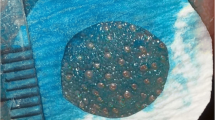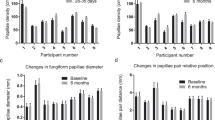Abstract
Objectives
The aim of this study was to evaluate the number, area, circumference, and circularity of lingual fungiform papillae and taste sensitivity in Behçet’s disease (BD) and the correlation with the disease.
Materials and methods
Eighty-six Behçet’s patients and 78 healthy control subjects were examined. After taking digital photographs from the tongue, the fungiform papillae evaluations were performed for the right and left tongue tip sites separately. Taste sense was evaluated with an electrogustometer (EG) from the same sites.
Results
The ANOVA test was used to evaluate the fungiform papillae number difference between BD and control groups, and the difference was statistically significant. The fungiform papillae number was significantly reduced in BD, 37.93 % at the left site and 40.13 % at the right site compared to controls. There was no significant difference in papillae area, circumference, circularity, and EG measurements between BD and control group.
Conclusion
According to these findings, it is conceivable that the reduction of the fungiform papillae number could be a sign of BD.
Clinical relevance
BD has different clinical features that are used for the diagnosis. This study provided a new possible clinical feature. Further studies should be carried out to investigate the usability of this new clinical feature for the diagnosis of BD.

Similar content being viewed by others
References
Mumcu G, Sur H, Inanc N, Karacayli U, Cimilli H, Sisman N, Ergun T, Direskeneli H (2009) A composite index for determining the impact of oral ulcer activity in Behçet’s disease and recurrent aphthous stomatitis. J Oral Pathol Med 38:785–791
Chang HK, Kim SY (2003) Survey and validation of the criteria for Behçet’s disease recently used in Korea: a suggestion for modification of the international study group criteria. J Korean Med Sci 18:88–92
Ilknur T, Pabuççuoglu U, Akın C, Lebe B, Gunes AT (2006) Histopathologic and direct immunofluorescence findings of the papulopustular lesions in Behçet’s disease. Eur J Dermatol 16:146–150
International Study Group for Behçet’s disease (1990) Criteria for diagnosis of Behçet’s disease. Lancet 335:1078–1080
Davis E, Melzer E (1969) A new sign in Behcet’s syndrome: scanty fungiform papillae in tongue. Arch Intern Med 124:720–721
Wöckel L, Jacob A, Holtmann M, Poustka F (2008) Reduced number of taste papillae in patients with eating disorders. J Neural Transm 115:537–544
Segovia C, Hutchinson I, Laing DG, Jinks AL (2002) A quantitative study of fungiform papillae and taste pore density in adults and children. Brain Res Dev Brain Res 138:135–146
Doty RL, Bagla R, Morgenson M, Mirza N (2001) NaCl thresholds: relationship to anterior tongue locus, area of stimulation, and number of fungiform papillae. Physiol Behav 72:373–378
Shahbake M, Hutchinson I, Laing DG, Jinks AL (2005) Rapid quantitative assessment of fungiform papillae density in the human tongue. Brain Res Dev Brain Res 1052:196–201
Negoro A, Umemoto M, Fukazawa K, Terada T, Sakagami M (2004) Observation of tongue papillae by video microscopy and contact endoscopy to investigate their correlation with taste function. Auris Nasus Larynx 31:255–259
Cheng LH, Robinson PP (1991) The distribution of fungiform papillae and taste buds on the human tongue. Arch Oral Biol 36:583–589
Stillman JA, Morton RP, Goldsmith D (2000) Automated electrogustometry: a new paradigm for the estimation of taste detection thresholds. Clin Otolaryngol Allied Sci 25:120–125
Miller SL, Mirza L, Doty RL (2002) Electrogustometric thresholds: relationship to anterior tongue locus, area of stimulation, and number of fungiform papillae. Physiol Behav 75:753–757
Lobb B, Elliffe DM, Stillman JA (2000) Reliability of electrogustometry for the estimation of taste thresholds. Clin Otolaryngol Allied Sci 25:531–534
Gardiner J, Barton D, Vanslambrouck JM, Braet F, Hall D, Marc J, Overall R (2008) Defects in tongue papillae and taste sensation indicate a problem with neurotrophic support in various neurological diseases. Neuroscientist 14:240–250
Bonfioli AA, Orefice F (2005) Behçet’s disease. Semin Ophthalmol 20:199–206
Bergman RA, Afifi AK, Heidger PM Jr (1996) The digestive system, Histology. W.B. Saunders Company, Philadelphia, pp 177–211
Evereklioglu C (2005) Current concepts in the etiology and treatment of Behçet disease. Surv Ophthalmol 50:297–350
Silverberg NB, Singh A, Echt AF, Laude TA (1996) Lingual fungiform papillae hypertrophy with cyclosporin A. Lancet 348:967
Kusakabe T, Matsuda H, Gono Y, Furukawa M, Hiruma H, Kawakami T, Tsukuda M, Takenaka T (1998) Immunohistochemical localisation of regulatory neuropaptides in human circumvallate papillae. J Anat 192:557–564
Astback J, Fernstrom A, Hylander B, Arvidson K, Johansson O (1999) Taste buds and neuronal markers in patients with chronic renal failure. Perit Dial Int 19:S315–S323
Aki T, Karıncaoglu Y, Seyhan M, Batcıoglu K (2006) Serum substance P and calitonin gene-related peptide levels in Behçet’s disease and their association with disease activity. Clin Exp Dermatol 31:583–587
Acknowledgments
We thank Ferit Avcu, Gülten Sungur, and Mehmet Kiyan for their very helpful comments during the study.
Conflict of interest
The authors declare that they have no conflict of interest.
Author information
Authors and Affiliations
Corresponding author
Rights and permissions
About this article
Cite this article
Akçiçek, G., Avcu, N. & Uysal, S. Evaluation of the fungiform papillae number in Behçet’s disease. Clin Oral Invest 19, 887–890 (2015). https://doi.org/10.1007/s00784-014-1298-y
Received:
Accepted:
Published:
Issue Date:
DOI: https://doi.org/10.1007/s00784-014-1298-y




